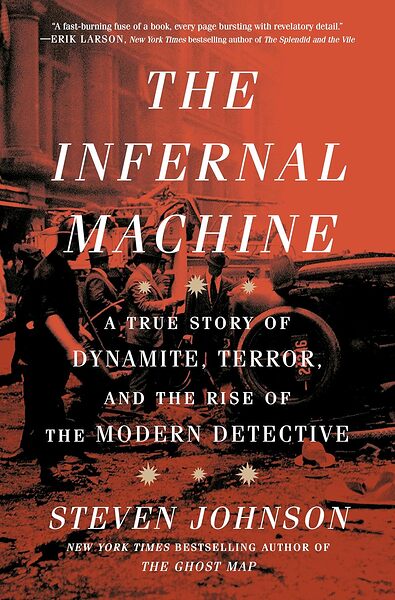Looking for a good read? Here is a recommendation. I have an unusual approach to reviewing books. I review books I feel merit a review. Each review is an opportunity to recommend a book. If I do not think a book is worth reading, I find another book to review. You do not have to agree with everything every author has written (I do not), but the fiction I review is entertaining (and often thought-provoking) and the non-fiction contain ideas worth reading.
Book Review
From Dynamite to the Surveillance State
Reviewed by Mark Lardas
May 19, 2024
“The Infernal Machine: A True Story of Dynamite, Terror, and the Rise of the Modern Detective,” by Steven Johnson, Crown, May 2024, 368 pages, $32.00 (Hardback), $13.99 (ebook)
Did Alfred Nobel lead to the surveillance state? A new book finds a connection.
“The Infernal Machine: A True Story of Dynamite, Terror, and the Rise of the Modern Detective,” by Steven Johnson shows how dynamite, anarchists and forensic science linked to create the modern state.
Nitroglycerine, discovered in the early 19th century, offered great promise in construction. It proved too volatile to use safely. Johnson shows how Alfred Nobel found a way to stabilize nitroglycerine; packing it in diatomaceous earth in a new product he named dynamite.
Concurrently a new political philosophy arose in Imperial Russia: anarchism. Developed by a Russian noble, Peter Kropotkin, it held man did not need government or top-down structures, but could flourish through voluntary cooperative effort.
Forensic science was also emerging. Pioneers, including Alphonse Bertillon and Francis Galton made biometric identification a useful tool in identifying criminals.
These seem to have little to do with each other. Nobel envisioned dynamite as a civil engineering tool, allowing roadbeds, tunnels and foundations to be dug more easily. Kropotkin believed anarchism a natural state, one that would produce peaceful coexistence. Forensics is concerned with crime, not civil engineering or peaceful coexistence. Johnson shows how the three entangled, often explosively.
Johnson opens by showing how Nobel developed dynamite. Her next shows how Kropotkin conceived anarchism during adventures in Siberia, pioneering the route of the Trans-Siberian Railroad, and how Bertillon used measurement of physical characteristics in Paris to identify criminals.
The tale takes a dark turn when fanatical followers of anarchism turned to violence to bring down the state, starting in Russia. Russia was an absolute monarchy. Johnson shows how anarchists used knives and gunpowder bombs for assassination.
The violence metastasized beyond Russia into Europe and finally North America. When assassination of political leaders failed to destroy the state, anarchists turned to terrorism, bombing public places to underscore their demands. They used dynamite bombs, due to their greater power. Soon organized crime joined in, using bombs as an extortion tool. Johnson shows how this led to the development of bomb squads in big cities, starting with New York, and eventually to centralized organizations like the FBI to counter terrorism in the early 20th century.
“The Infernal Machine” is a fascinating study of unintended consequences. It is a comprehensive study of an extreme political movement, organizational reaction to it, and the resulting centralization of power. Johnson has written an absorbing book.
Mark Lardas, an engineer, freelance writer, historian, and model-maker, lives in League City. His website is marklardas.com.
